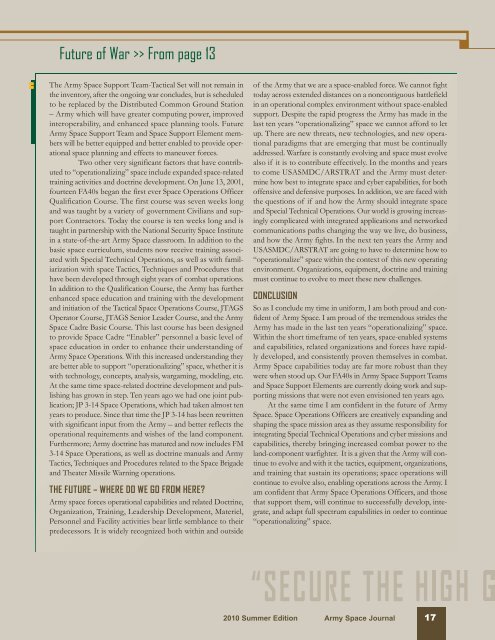Volume 9, Number 2 - Space and Missile Defense Command - U.S. ...
Volume 9, Number 2 - Space and Missile Defense Command - U.S. ...
Volume 9, Number 2 - Space and Missile Defense Command - U.S. ...
Create successful ePaper yourself
Turn your PDF publications into a flip-book with our unique Google optimized e-Paper software.
Future of War >> From page 13<br />
The Army <strong>Space</strong> Support Team-Tactical Set will not remain in<br />
the inventory, after the ongoing war concludes, but is scheduled<br />
to be replaced by the Distributed Common Ground Station<br />
– Army which will have greater computing power, improved<br />
interoperability, <strong>and</strong> enhanced space planning tools. Future<br />
Army <strong>Space</strong> Support Team <strong>and</strong> <strong>Space</strong> Support Element members<br />
will be better equipped <strong>and</strong> better enabled to provide operational<br />
space planning <strong>and</strong> effects to maneuver forces.<br />
Two other very significant factors that have contributed<br />
to “operationalizing” space include exp<strong>and</strong>ed space-related<br />
training activities <strong>and</strong> doctrine development. On June 13, 2001,<br />
fourteen FA40s began the first ever <strong>Space</strong> Operations Officer<br />
Qualification Course. The first course was seven weeks long<br />
<strong>and</strong> was taught by a variety of government Civilians <strong>and</strong> support<br />
Contractors. Today the course is ten weeks long <strong>and</strong> is<br />
taught in partnership with the National Security <strong>Space</strong> Institute<br />
in a state-of-the-art Army <strong>Space</strong> classroom. In addition to the<br />
basic space curriculum, students now receive training associated<br />
with Special Technical Operations, as well as with familiarization<br />
with space Tactics, Techniques <strong>and</strong> Procedures that<br />
have been developed through eight years of combat operations.<br />
In addition to the Qualification Course, the Army has further<br />
enhanced space education <strong>and</strong> training with the development<br />
<strong>and</strong> initiation of the Tactical <strong>Space</strong> Operations Course, JTAGS<br />
Operator Course, JTAGS Senior Leader Course, <strong>and</strong> the Army<br />
<strong>Space</strong> Cadre Basic Course. This last course has been designed<br />
to provide <strong>Space</strong> Cadre “Enabler” personnel a basic level of<br />
space education in order to enhance their underst<strong>and</strong>ing of<br />
Army <strong>Space</strong> Operations. With this increased underst<strong>and</strong>ing they<br />
are better able to support “operationalizing” space, whether it is<br />
with technology, concepts, analysis, wargaming, modeling, etc.<br />
At the same time space-related doctrine development <strong>and</strong> publishing<br />
has grown in step. Ten years ago we had one joint publication;<br />
JP 3-14 <strong>Space</strong> Operations, which had taken almost ten<br />
years to produce. Since that time the JP 3-14 has been rewritten<br />
with significant input from the Army – <strong>and</strong> better reflects the<br />
operational requirements <strong>and</strong> wishes of the l<strong>and</strong> component.<br />
Furthermore; Army doctrine has matured <strong>and</strong> now includes FM<br />
3-14 <strong>Space</strong> Operations, as well as doctrine manuals <strong>and</strong> Army<br />
Tactics, Techniques <strong>and</strong> Procedures related to the <strong>Space</strong> Brigade<br />
<strong>and</strong> Theater <strong>Missile</strong> Warning operations.<br />
THE FUTURE – WHERE DO WE GO FROM HERE?<br />
Army space forces operational capabilities <strong>and</strong> related Doctrine,<br />
Organization, Training, Leadership Development, Materiel,<br />
Personnel <strong>and</strong> Facility activities bear little semblance to their<br />
predecessors. It is widely recognized both within <strong>and</strong> outside<br />
of the Army that we are a space-enabled force. We cannot fight<br />
today across extended distances on a noncontiguous battlefield<br />
in an operational complex environment without space-enabled<br />
support. Despite the rapid progress the Army has made in the<br />
last ten years “operationalizing” space we cannot afford to let<br />
up. There are new threats, new technologies, <strong>and</strong> new operational<br />
paradigms that are emerging that must be continually<br />
addressed. Warfare is constantly evolving <strong>and</strong> space must evolve<br />
also if it is to contribute effectively. In the months <strong>and</strong> years<br />
to come USASMDC/ARSTRAT <strong>and</strong> the Army must determine<br />
how best to integrate space <strong>and</strong> cyber capabilities, for both<br />
offensive <strong>and</strong> defensive purposes. In addition, we are faced with<br />
the questions of if <strong>and</strong> how the Army should integrate space<br />
<strong>and</strong> Special Technical Operations. Our world is growing increasingly<br />
complicated with integrated applications <strong>and</strong> networked<br />
communications paths changing the way we live, do business,<br />
<strong>and</strong> how the Army fights. In the next ten years the Army <strong>and</strong><br />
USASMDC/ARSTRAT are going to have to determine how to<br />
“operationalize” space within the context of this new operating<br />
environment. Organizations, equipment, doctrine <strong>and</strong> training<br />
must continue to evolve to meet these new challenges.<br />
CONCLUSION<br />
So as I conclude my time in uniform, I am both proud <strong>and</strong> confident<br />
of Army <strong>Space</strong>. I am proud of the tremendous strides the<br />
Army has made in the last ten years “operationalizing” space.<br />
Within the short timeframe of ten years, space-enabled systems<br />
<strong>and</strong> capabilities, related organizations <strong>and</strong> forces have rapidly<br />
developed, <strong>and</strong> consistently proven themselves in combat.<br />
Army <strong>Space</strong> capabilities today are far more robust than they<br />
were when stood up. Our FA40s in Army <strong>Space</strong> Support Teams<br />
<strong>and</strong> <strong>Space</strong> Support Elements are currently doing work <strong>and</strong> supporting<br />
missions that were not even envisioned ten years ago.<br />
At the same time I am confident in the future of Army<br />
<strong>Space</strong>. <strong>Space</strong> Operations Officers are creatively exp<strong>and</strong>ing <strong>and</strong><br />
shaping the space mission area as they assume responsibility for<br />
integrating Special Technical Operations <strong>and</strong> cyber missions <strong>and</strong><br />
capabilities, thereby bringing increased combat power to the<br />
l<strong>and</strong>-component warfighter. It is a given that the Army will continue<br />
to evolve <strong>and</strong> with it the tactics, equipment, organizations,<br />
<strong>and</strong> training that sustain its operations; space operations will<br />
continue to evolve also, enabling operations across the Army. I<br />
am confident that Army <strong>Space</strong> Operations Officers, <strong>and</strong> those<br />
that support them, will continue to successfully develop, integrate,<br />
<strong>and</strong> adapt full spectrum capabilities in order to continue<br />
“operationalizing” space.<br />
2010 Summer Edition Army <strong>Space</strong> Journal 17
















